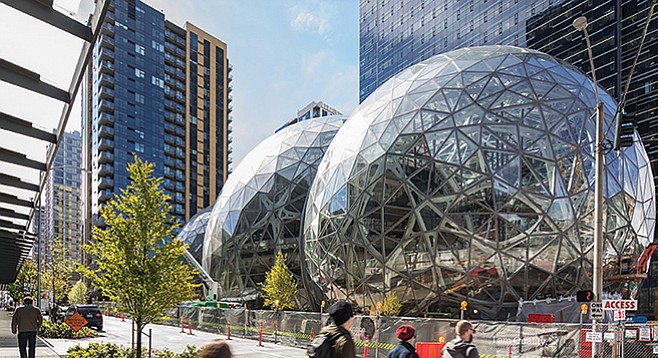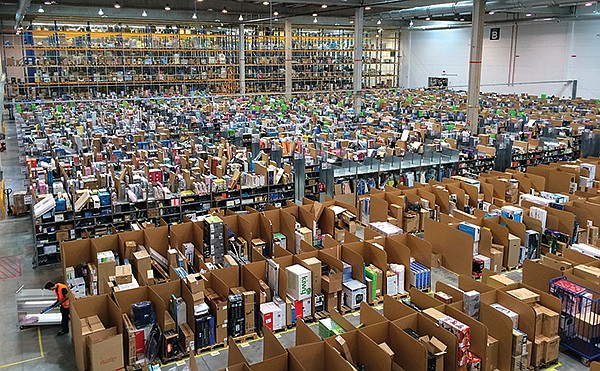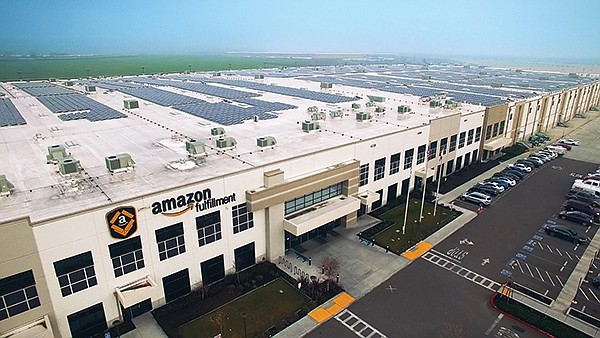 Facebook
Facebook
 X
X
 Instagram
Instagram
 TikTok
TikTok
 Youtube
Youtube

San Diego County put forth four locations to get in on the Amazon bidding — the contest among 238 metro areas to become the huge retailer’s second headquarters, now called Amazon HQ2. Twenty metro areas (not including any in San Diego County) are finalists in the parade.

Parade? Make it charade. That’s because those who know the corporate relocation scam are stating clearly that the Amazon circus exists primarily to drive up government subsidies to be snatched from the winner, which would have been chosen anyway.
This is a bribe game, in essence utilizing shill bidding. Governments — really, taxpayers — shell out big bucks to get a company to locate or relocate to their areas. This delusory sport has been going on for around 80 years in the United States, and it is getting worse every year. Amazon may top the current leader, Walmart.

Amazon is studying the 20 surviving bribe offers. But the company’s location decision won’t be based on the fattest bribe. Amazon is staging “a public-relations stunt, apparently to attract the largest possible subsidies from its chosen site,” says Greg LeRoy, executive director of the Washington DC–based research group named Good Jobs First.
The decision won’t be made on the size of the so-called incentives. Explains LeRoy, “In this case, as in any large corporate headquarters siting, the key variable is the executive talent pool.”
The winner will show that it can pick up smart engineering, finance, law, and marketing talent from other companies in the area and from local universities. But Amazon wants to get as much money as it can from the winner, in addition to that talent.
Amazon said from the outset that it wants a business-friendly environment and tax structure. In short, it wants a location that will shovel out corporate welfare, possibly in a form of tax relief. These are considered “incentives” — land, site preparation, tax credits and exemptions, relocation grants, workforce grants, utility incentives and grants, fee reduction, and the like. In short, moolah.
However, “The factor that’s going to make the most difference is the availability of talent…. The location decision is going to be made by the human resources department,” says Joseph Cortright of Portland, Oregon–based Impresa. “Amazon, General Electric, and dozens of others go through the ritual of pretending to entertain a wide range of proposals and use the leverage of competing bids to sweat the best possible deal out of their preferred location.” This Kabuki dance provides “giant cash rewards to those who engage in the most cynical behavior.”
And, adds Cortright, “While Amazon may turn out to be a winner, it may come at the cost of fiscally impoverishing the city that it chooses to locate in.” In fact, that is one of the biggest dangers of this game: the city or county showers too much money on the company moving there. Schools suffer. Infrastructure collapses. Services erode. The company may have promised to stay for, say, 25 years. When the 25 years are up, the firm goes looking for another location and subsidy. It can’t attract talent to a run-down city.
There is a history of subsidies backfiring. In the 1980s, cities rushed to subsidize a home for General Motors’ exciting new brand, Saturn. It lasted 14 years. The once-fabled retailer Sears Roebuck built its famous tower in downtown Chicago. Then it got into trouble. It threatened to leave Illinois. The state came to the rescue with a fat subsidy to move the ailing company to the suburbs. Sears kept collapsing and demanded another subsidy or it would leave. Illinois coughed up $275 million. Sears, now gravely ill along with its parent company, is still in the suburb, but Illinois — in horrible shape financially — has given away $5 billion in such deals.
Amazon has another subterfuge for sucking money out of governments. It’s known as Supplemental Nutrition Assistance Program — it used to be called “food stamps.” A research group, Policy Matters Ohio, showed that more than one out of ten Amazon employees in the state are in this program. Reason: the company’s pay is so low. Other companies such as Walmart, Home Depot, and Target are infamous for this ruse. Some even teach employees how to fill out government forms for such welfare. So when you think you have gotten a great deal on Amazon or Walmart merchandise, think again. Your taxes are permitting the company to pay such low wages and keep its prices low. Your taxes may make up the difference between the discounter’s price and that of a local merchant.
Amazon is the master at extracting money from governments. For years, it didn’t collect sales taxes on online purchases. This gave it an advantage over brick-and-mortar retailers. However, once a company locates a business in a state, it must collect sales taxes. As Amazon grew, it had to have more warehouses and distribution centers. Thus, state-by-state, it had to collect taxes.
But these Amazonians play rough. As they planned new distribution centers, they pulled the same stunt: which municipality will give us the biggest subsidy? LeRoy of Good Jobs First says that in this process of locating warehouses, distribution centers, and the like, Amazon has received $1.1 billion in subsidies.
Good Jobs First has an up-to-date compilation of how much cities have shelled out to Amazon to get the company’s warehouse-like buildings (called “fulfillment centers”): Cayce, South Carolina, $61 million; Kenosha, Wisconsin, $32 million; Newark, $39 million; Baltimore, $45 million; and North Haven, Connecticut, $25 million. But many municipalities hide the giveaways from the community. Here are some metro areas whose gifts to Amazon have been wholly or partly kept secret: Katy, Texas; Hazelwood, Missouri; Troutdale, Oregon; Coppell, Texas; Harris County, Texas; Dallas County, Texas; Bradley County, Tennessee; Wilson County, Tennessee; Lexington County, South Carolina; and Maricopa County, Arizona.
The Good Jobs First website has reams of information on taxpayer subsidies going to companies. It mentions San Diego’s subsidy to the Padres. But I could not find a reference to an even bigger windfall: John Moores’s company getting all that Ballpark District land for extremely low prices, possibly resulting in profits of $1 billion.


San Diego County put forth four locations to get in on the Amazon bidding — the contest among 238 metro areas to become the huge retailer’s second headquarters, now called Amazon HQ2. Twenty metro areas (not including any in San Diego County) are finalists in the parade.

Parade? Make it charade. That’s because those who know the corporate relocation scam are stating clearly that the Amazon circus exists primarily to drive up government subsidies to be snatched from the winner, which would have been chosen anyway.
This is a bribe game, in essence utilizing shill bidding. Governments — really, taxpayers — shell out big bucks to get a company to locate or relocate to their areas. This delusory sport has been going on for around 80 years in the United States, and it is getting worse every year. Amazon may top the current leader, Walmart.

Amazon is studying the 20 surviving bribe offers. But the company’s location decision won’t be based on the fattest bribe. Amazon is staging “a public-relations stunt, apparently to attract the largest possible subsidies from its chosen site,” says Greg LeRoy, executive director of the Washington DC–based research group named Good Jobs First.
The decision won’t be made on the size of the so-called incentives. Explains LeRoy, “In this case, as in any large corporate headquarters siting, the key variable is the executive talent pool.”
The winner will show that it can pick up smart engineering, finance, law, and marketing talent from other companies in the area and from local universities. But Amazon wants to get as much money as it can from the winner, in addition to that talent.
Amazon said from the outset that it wants a business-friendly environment and tax structure. In short, it wants a location that will shovel out corporate welfare, possibly in a form of tax relief. These are considered “incentives” — land, site preparation, tax credits and exemptions, relocation grants, workforce grants, utility incentives and grants, fee reduction, and the like. In short, moolah.
However, “The factor that’s going to make the most difference is the availability of talent…. The location decision is going to be made by the human resources department,” says Joseph Cortright of Portland, Oregon–based Impresa. “Amazon, General Electric, and dozens of others go through the ritual of pretending to entertain a wide range of proposals and use the leverage of competing bids to sweat the best possible deal out of their preferred location.” This Kabuki dance provides “giant cash rewards to those who engage in the most cynical behavior.”
And, adds Cortright, “While Amazon may turn out to be a winner, it may come at the cost of fiscally impoverishing the city that it chooses to locate in.” In fact, that is one of the biggest dangers of this game: the city or county showers too much money on the company moving there. Schools suffer. Infrastructure collapses. Services erode. The company may have promised to stay for, say, 25 years. When the 25 years are up, the firm goes looking for another location and subsidy. It can’t attract talent to a run-down city.
There is a history of subsidies backfiring. In the 1980s, cities rushed to subsidize a home for General Motors’ exciting new brand, Saturn. It lasted 14 years. The once-fabled retailer Sears Roebuck built its famous tower in downtown Chicago. Then it got into trouble. It threatened to leave Illinois. The state came to the rescue with a fat subsidy to move the ailing company to the suburbs. Sears kept collapsing and demanded another subsidy or it would leave. Illinois coughed up $275 million. Sears, now gravely ill along with its parent company, is still in the suburb, but Illinois — in horrible shape financially — has given away $5 billion in such deals.
Amazon has another subterfuge for sucking money out of governments. It’s known as Supplemental Nutrition Assistance Program — it used to be called “food stamps.” A research group, Policy Matters Ohio, showed that more than one out of ten Amazon employees in the state are in this program. Reason: the company’s pay is so low. Other companies such as Walmart, Home Depot, and Target are infamous for this ruse. Some even teach employees how to fill out government forms for such welfare. So when you think you have gotten a great deal on Amazon or Walmart merchandise, think again. Your taxes are permitting the company to pay such low wages and keep its prices low. Your taxes may make up the difference between the discounter’s price and that of a local merchant.
Amazon is the master at extracting money from governments. For years, it didn’t collect sales taxes on online purchases. This gave it an advantage over brick-and-mortar retailers. However, once a company locates a business in a state, it must collect sales taxes. As Amazon grew, it had to have more warehouses and distribution centers. Thus, state-by-state, it had to collect taxes.
But these Amazonians play rough. As they planned new distribution centers, they pulled the same stunt: which municipality will give us the biggest subsidy? LeRoy of Good Jobs First says that in this process of locating warehouses, distribution centers, and the like, Amazon has received $1.1 billion in subsidies.
Good Jobs First has an up-to-date compilation of how much cities have shelled out to Amazon to get the company’s warehouse-like buildings (called “fulfillment centers”): Cayce, South Carolina, $61 million; Kenosha, Wisconsin, $32 million; Newark, $39 million; Baltimore, $45 million; and North Haven, Connecticut, $25 million. But many municipalities hide the giveaways from the community. Here are some metro areas whose gifts to Amazon have been wholly or partly kept secret: Katy, Texas; Hazelwood, Missouri; Troutdale, Oregon; Coppell, Texas; Harris County, Texas; Dallas County, Texas; Bradley County, Tennessee; Wilson County, Tennessee; Lexington County, South Carolina; and Maricopa County, Arizona.
The Good Jobs First website has reams of information on taxpayer subsidies going to companies. It mentions San Diego’s subsidy to the Padres. But I could not find a reference to an even bigger windfall: John Moores’s company getting all that Ballpark District land for extremely low prices, possibly resulting in profits of $1 billion.
Comments